2018 Hyundai Kona Review and First Drive


Mediocrity is born from being lazy and too comfortable and Hyundai is not having any of that.
Not interested in making lackluster products, Hyundai has taken tangible steps to rise above its competition and those efforts are obvious in the Korean brand’s new Kona, its first subcompact crossover. Although it’s a latecomer to the market, it has learned from the mistakes of its peers (mainly the Toyota C-HR, Honda HR-V, and Mazda CX-3) and will likely become the new segment benchmark.
Fresh Style
Based on looks alone, the Hyundai Kona has a lot going for it and could be one of the most stylish CUVs in its class. While the Honda looks frumpy and the Toyota is too divisive (although I love the C-HR’s funky style), the Kona sits in the middle of the style spectrum – different enough to get some eyeballs but not radical enough to turn people off entirely. Although its design isn’t perfect — there’s a bit too much cheap plastic body cladding in some corners and too many fake air intakes — it’s up there in attractiveness with the CX-3 and Jeep Renegade.
FAST FACTS
| Engine: | 2.0L 4-cyl/1.6L turbo 4-cyl |
| Output: | 147 hp, 132 lb-ft/175 hp, 195 lb-ft of torque |
| Transmission: | 6-speed auto/7-speed DCT |
| US Fuel Economy (AWD MPG): | 25/30/27 (2.0L) | 26/29/27 (1.6L turbo) |
| CAN Fuel Economy (AWD L/100 km): | 9.2/7.8/8.6 (2.0L) | 9.0/8.0/8.6 (1.6L turbo) |
| US Price: | Starts at $20,240/$29,650 fully loaded |
| CAN Price: | Starts at $22,931/$33,881 fully loaded |
| : | (All pricing includes destination) |

The fact that the Kona is offered in some amazing colors like Acid Yellow, Tangerine Comet, and Blue Lagoon along with an optional cool contrast roof will go a long way into getting attention from CUV shoppers. The Kona manages to stand out and actually have a personality, which can’t be said for many of its competitors.
Interior is Actually Interesting
That personality carries over into the interior, which is rare in a class known for its no-frills approach. The Kona is available with Acid Yellow (looks more like lime green) contrast piping in the leather seats or houndstooth cloth, which is cooler than anything in this segment has a right to be (I mean, a Porsche 911 R comes with houndstooth seats). Matching matte-finish Acid Yellow/lime green trim and contrast stitching is optional inside, which I’d say is completely necessary — it livens up the cabin and makes it a lot of fun, although it would clash with most color options. This trim option is only available in the Acid Yellow, but I would have loved to see it available to match all exterior paint colors. Optioned out with these cool touches, the Kona might have the best interior in its class, but without it, it can feel rather ordinary and drab. The fact that it’s well-built, doesn’t feel oppressively cheap, and is logically laid out and functional, however, is a big bonus.
The infotainment system is modern, user-friendly, quick, responsive, and comes in two sizes (in use, it’s much better than what Toyota, Honda, and Mazda offer in this segment and is bested only by Jeep’s excellent UConnect). The physical buttons that flank the touchscreen make it even easier to use and Apple CarPlay and Android Auto are standard. Everything is clearly labeled, inherently intuitive, and there are no mystery buttons anywhere.

The only downsides to the interior are that there’s only one USB port and two cigarette lighter adapters, which absolutely no one uses anymore. In 2018, it doesn’t make sense to have just one USB port. They should have gotten rid of the useless lighter adapters and put in two USB ports instead: one for Apple CarPlay/Android Auto, and the other for fast charging. Upper trims that have a wireless charging pad that helps matters slightly. There’s also a useful tray in the center console that’s perfect for storing a phone or wallet.
ALSO SEE: Hyundai Kona Electric Debuts With 298 Miles of Driving Range
The rear seats are also not terrible, unless someone very tall is in the front, which turns the Kona into a 2+2. Rear seat occupants get no USBs or pretty much anything, but it’s not torture to be back there.
Trunk space measures in at 19.2 cubic feet (544 L) with the seats up and 45.8 cu-ft (1,296 L) with the 40/60 seats folded down. The trunk also has a useful under-floor storage cubby. It’s not as cargo-hungry as the HR-V, but does hold more than the CX-3 and the C-HR.
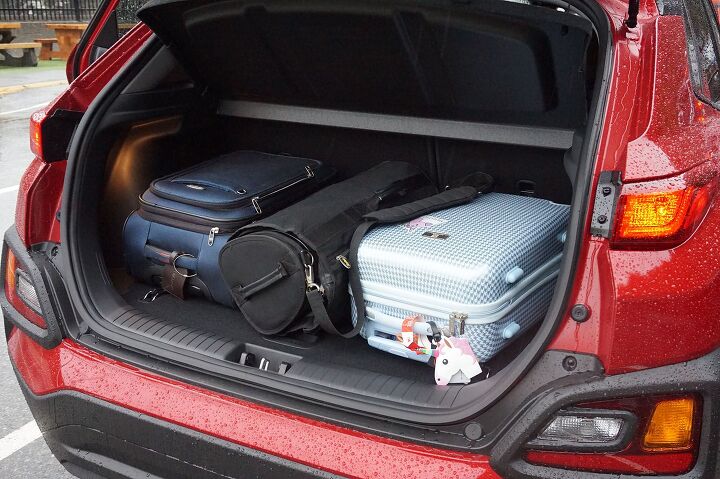
One standout tech feature is the optional head-up display (though it isn’t a true projector type) that shows a lot of useful information. It’s pretty fantastic that it’s even offered in this price bracket (the CX-3 is the only other one that has one). The Kona is also available with lane-keep assist, forward collision alert with pedestrian detection, rear cross traffic alert, a reverse camera, heated seats, a heated steering wheel, high beam assist, and blind spot monitoring, but no adaptive cruise control, a glaring omission.
Driving Dynamics
Driven on some winding, wet roads around Vancouver Island, British Columbia, the Kona was not at all sloppy, as I was half expecting it to be, because that’s what most other cars in this segment are like. The Kona is surprisingly composed in a corner and although it’s not sporty, it definitely feels solid and not as disconnected and numb as many other cars in this segment.

The suspension is comfortable without being too squishy, and athletic but not crashy over rough roads. The steering had an unexpected heft and crispness to it with only a little looseness on center and it was refreshing to see an automaker other than Mazda step up the level of driving dynamics in this segment. The Toyota C-HR is actually really fun to chuck into corners, but it suffers from not being available with all-wheel drive and from being too slow. The Kona fixes that with an optional turbo engine (no other car in this class offers two engine choices) and optional AWD. Bonus points: The Kona has a locking diff and hill descent control.
ALSO SEE: 2018 Hyundai Kona Pros and Cons
Two engines are available: a base naturally aspirated 2.0-liter four-cylinder with 147 horsepower and 132 pound-feet of torque and a 1.6-liter turbo four-cylinder with 175 hp and a healthy 195 lb-ft of torque.
The base engine is fine but gets very harsh and loud when stronger acceleration is called for (though it’s still not as awful as the HR-V’s engine). It struggled a lot trying to pass slower traffic or accelerate up a hill. This engine is paired with a six-speed automatic transmission and is rated at 25 mpg in the city, 30 on the highway, and 27 combined (9.2/7.8/8.6 L/100 km) for the AWD model.
The engine you want is the uplevel and refined 1.6-liter turbo, which performs much more convincingly and adds to the Kona’s fun personality. The 1.6L turbo, which is paired with a seven-speed dual clutch transmission, has a healthy amount usable torque early in the rev range, which is always more important than flat out horsepower.

The DCT was also predictable and intuitive — during my time with it, I experienced no weirdness typical to Hyundai DCTs in the past, no juddering at low speeds and no harsh shifts. This engine is expected to get 26 mpg in the city, 29 on the highway, and 27 combined (9.0/8.0/8.6 L/100 km) for the AWD model, exactly the same as the base engine combined, so it’s definitely the more compelling pick of the two.
Add in the fact that the Kona makes a strong value play with a starting price of $20,240 ($22,931 in Canada, all pricing includes destination fees) and a fully loaded ask of an entirely reasonable $29,650 ($33,881 in Canada), and there’s very little reason not to pick this crossover over its competitors.
The Verdict: 2018 Hyundai Kona Review
Hyundai has made a legitimate effort to ensure this car is a segment leader, and the result is a subcompact crossover that easily outshines a lot of its competition in nearly all areas — it has the right stuff to be a segment leader. Many of the Kona’s competitors have a few redeeming factors and are otherwise mediocre, but Kona is the whole package. It’s very refreshing to see a car in this segment that doesn’t cut corners and is genuinely kind of cool.
Discuss this article on our Hyundai Kona Forum
LOVE IT
- Funky style, great colors
- Turbo engine
- Crisp driving dynamics
- Well-priced
- Fun personality
- Interesting interior
LEAVE IT
- Only 1 USB port
- Fake air intakes
- No adaptive cruise control

Jodi has been obsessed with cars since she was little and has been an automotive journalist for the past 12 years. She has a Bachelor of Journalism from Ryerson University in Toronto, is a member of the Automobile Journalists Association of Canada (AJAC), and a jury member for the prestigious North American Car/Truck/Utility Vehicle of the Year (NACTOY). Besides hosting videos, and writing news, reviews and features, Jodi is the Editor-in-Chief of AutoGuide.com and takes care of the site's day-to-day operations.
More by Jodi Lai





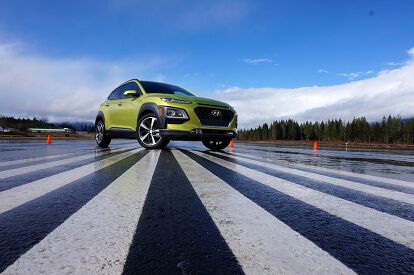





















































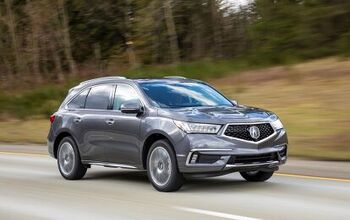







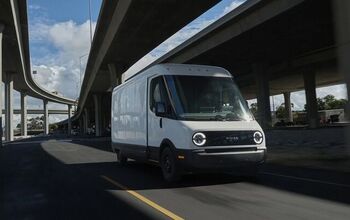






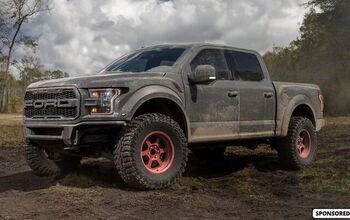


Comments
Join the conversation
Now make an "N" Version and slap a turbo on that 2.0L!
when I looked at the Kona at a dealership I found it to be very small and very basic and plain. To get all the extras mentioned above you are putting the cost up to the point of being in the Santa Fe price range...bigger, roomier, more comfortable and more standard 'extra's.